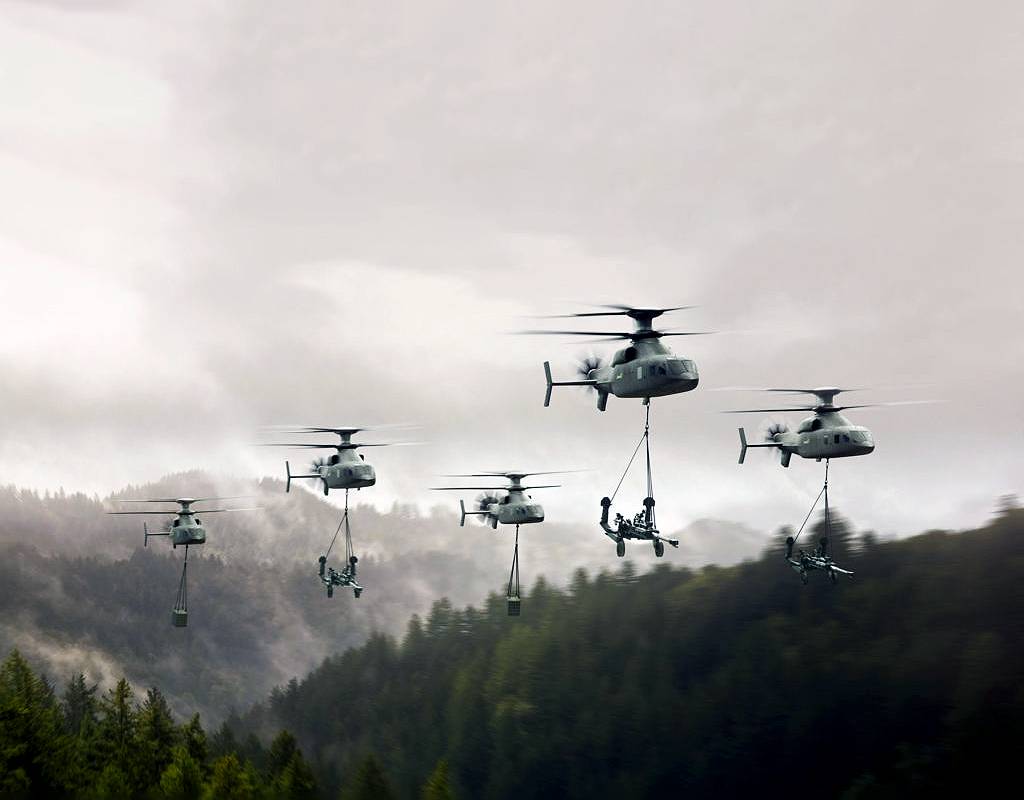
When it comes online in the 2030s, the Future Long Range Assault Aircraft (FLRAA) will be designed specifically for the U.S. Army, but could also fit the bill for other services looking to replace their versions of the UH-60 Black Hawk.
Dead-set to land on a Black Hawk replacement that suits their service’s needs, Army aviation leaders also believe FLRAA could eventually become a joint rotorcraft acquisition effort to rival the ubiquitous adoption and historic utility of the Black Hawk and its numerous variants.
For the sake of interoperability and cost efficiency, finding more buyers for FLRAA makes sense, according to the generals in charge of modernizing the Army’s rotorcraft fleets. They foresee the program ultimately ballooning to include multiple variants of the same aircraft — likely either the Bell V-280 advanced tiltrotor or Sikorsky-Boeing Defiant X compound coaxial helicopter — much as the Black Hawk grew from an Army program to one of the most prolific military rotorcraft in history.
“I’m mindful that the most successful joint program ever was the Black Hawk and it was something run by our great [aviation program office],” Maj. Gen. Walter Rugen, chief of the Army’s Future Vertical Lift program, said March 17 at the Association of the U.S. Army’s virtual Global Force Next Conference.
The Army picked the UH-60A as the primary utility helicopter in 1976. From the original Black Hawk sprang dozens of variants now flown by the U.S. Navy, Air Force, Coast Guard, federal law enforcement agencies and more than two dozen international militaries. At least 4,000 Black Hawks are currently in service.
As the operator of by far the largest H-60 fleet — about 2,100 helicopters — the Army is leading the FLRAA charge and has shouldered much of the government investment in the project. It also will buy more of the resultant aircraft than other services or international partners, though the Army hasn’t said exactly how many.
Watching and waiting for what comes of the Army program is the U.S. Navy, which foresees a need to replace the MH-60R/S Sea Hawk and MQ-8 Fire Scout unmanned shipboard rotorcraft. The Navy recently launched the Future Vertical Lift Maritime Strike program that will find a suitable aircraft to take on the Sea Hawk and Fire Scout roles when they begin to retire in 2030s.

Army colonels, one-, two- and three-star generals routinely meet with their counterparts in other services to discuss aviation modernization, Rugen said.
“That conversation continues,” Rugen said. “I think there’s some wait-and-see. I think they are pleased to wait and see, because again, our great enterprise approach is producing significant results and I think we do look far more like the Black Hawk as a great joint program coming forward.”
On a much smaller scale, the U.S. Coast Guard also is monitoring FLRAA for a potential successor to the MH-60T Jayhawk. Coast Guard Commandant Karl Schultz has said the service is “absolutely tied” to the Army-led FVL development effort. The Coast Guard could choose the marinized version of FLRAA that likely will result from the Navy’s effort, but is currently focused on modernizing its fleet of Jayhawks and MH-65 Dolphins in the 10-year window before any FLRAA aircraft becomes available.
“When you look at the future of rotary wing aviation, I think the future vertical lift is where an awful lot of the focus is by the industry, so I think we will watch that. We will stay in tune with that,” Schultz told reporters in a recent conference call.
Brig. Gen. Robert Barrie, the Army’s aviation program executive officer, said the Army acknowledges that FLRAA may meet the requirements for other services to replace their helicopters. But the benefits of widening the modernization target must be balanced with the Army’s immediate requirement for an affordable UH-60 replacement, Barrie said during the March 17 conference.
“If we’re going to carry the Black Hawk example forward, the A-model Black Hawk, that’s what we’re trying to do with increment one of FLRAA,” Barrie said. “What we are not going to do is build in pre-existing capability onto the platform in anticipation of future requirements. It’s nuanced, but we’re looking at if there is robustness in the design that allows us to account for what our future acknowledged potential requirements — from either a joint service or a potential international customer.”
“The requirement today acknowledges that there is joint interest, but it is the Army’s requirement and we’re working through the FVL [cross-functional team] to make sure it’s captured and then increment one we deliver rapidly and affordable capability for the Army,” Barrie added.


